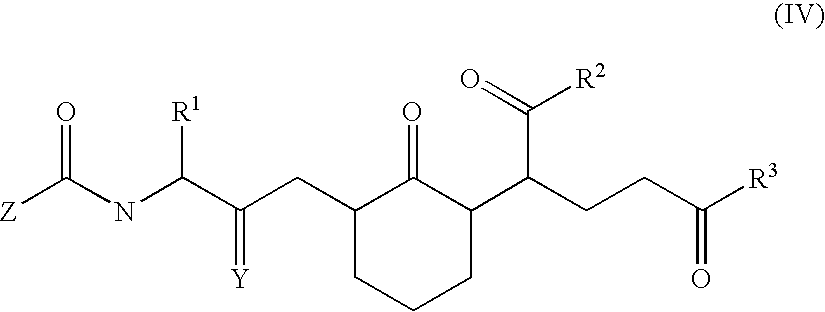Compounds and methods to inhibit or augment an inflammatory response
- Summary
- Abstract
- Description
- Claims
- Application Information
AI Technical Summary
Benefits of technology
Problems solved by technology
Method used
Image
Examples
example 1
Identification and Characterization of Pan-Chemokine Peptide Inhibitors
[0433]Based on an alignment of MCP-1 sequences from different species, three regions in MCP-1 were identified which were conserved between all the species examined. Three purified (>95% purity) peptides (12–15mers) were prepared which had the greatest sequence homology between the human and mouse MCP-1 sequences (Table 1). These peptides were screened for their ability to inhibit hMCP-1 induced THP1 migration. Similarly, the sequences of Xenopus laevis TGF-beta1 and TGF-beta3 and human TGF-beta1 and TGF-beta3 were compared, and 3 regions (each 10mer) of perfect homology were identified. These peptides were termed “betatides”.
[0434]For this assay, THP-1 cells were maintained at a density of 4×105 cells per ml in RPMI-1640 supplemented with 10% fetal calf serum +20 μM 2-mercaptoethanol. Chemotaxis was induced in a 96-well disposable chemotaxis chamber fitted with a 5 μM polycarbonate filter (PVP free, ChemoTX, Neur...
example 2
Characterization of Fragments and Variants of Peptide 3(1–12)[MCP-1] and Peptide 2 [MCP-1]
[0445]To determine whether a fragment of peptide 3 has biological activity and selectivity, two 6mer “half-peptides” were analyzed (Table 3): EICADP (SEQ ID NO:8), corresponding to peptide 3(1–6)[MCP-1], and KQKWVQ (SEQ ID NO:9), corresponding to peptide 3(7–12)[MCP-1]. Peptide 3(7–12)[MCP-1] (SEQ ID NO:8) was as potent an inhibitor of CC chemokine signaling as peptide 3(1–12)[MCP-1] (SEQ ID NO:1), but was noticeably more potent as an inhibitor of CXC chemokines (Table 4). In contrast, peptide 3(1–6)[MCP-1] (SEQ ID NO:8) was much less potent as an inhibitor than peptide 3(1–12)[MCP-1] (SEQ ID NO:1).
[0446]
TABLE 3NAMESEQUENCESOURCEPeptide 1 familyPep1AQPDAINAPVTCCResidues 1–13 of(SEQ ID NO:2)mature hMCP-1Peptide 2 familyPep2(1–15)[MCP1]SYRRITSSKCPKEAVResidues 28–42 of(SEQ ID NO:3)mature hMCP-1Pep2(1–15)[SDF1]HLKILNTPNCALQIVResidues 26–40 of(SEQ ID NO:4)mature hSDF-1βPep2(1–14)[MIP1α]DYFETSSQCSKPG...
example 3
Identification and Characterization of Chemokine Sequences that are Functional Agonists
[0457]The results described above, that peptide 2(1–15)[MCP-1] (SEQ ID NO:3) did not inhibit MCP-1 activity in the THP-1 migration assay, did not exclude the possibility that peptide 2(1–15)[MCP-1] (SEQ ID NO:3) associates with the MCP-1 receptor and either fails to inhibit MCP-1 binding and signaling, or acts as an agonist, preventing binding of MCP-1 but transducing an MCP-1 like signal. To determine whether peptide 2(1–15)[MCP-1] (SEQ ID NO:3) binds to chemokine receptors, THP-1 cells were mixed with a biotinylated derivative of peptide. Peptide 2(1–15)[MCP-1] (SEQ ID NO:3) was found to bind to THP-1 cells with a reasonable affinity (kD=1.9 μM), suggesting that peptide 2(1–15)[MCP-1] (SEQ ID NO:3) was able to interact with chemokine receptors without inhibiting chemokine signaling (a neutral binding agent).
[0458]Unlike peptide 3, which represents a region that is relatively conserved between ch...
PUM
| Property | Measurement | Unit |
|---|---|---|
| Time | aaaaa | aaaaa |
| Time | aaaaa | aaaaa |
| Time | aaaaa | aaaaa |
Abstract
Description
Claims
Application Information
 Login to View More
Login to View More - R&D
- Intellectual Property
- Life Sciences
- Materials
- Tech Scout
- Unparalleled Data Quality
- Higher Quality Content
- 60% Fewer Hallucinations
Browse by: Latest US Patents, China's latest patents, Technical Efficacy Thesaurus, Application Domain, Technology Topic, Popular Technical Reports.
© 2025 PatSnap. All rights reserved.Legal|Privacy policy|Modern Slavery Act Transparency Statement|Sitemap|About US| Contact US: help@patsnap.com



